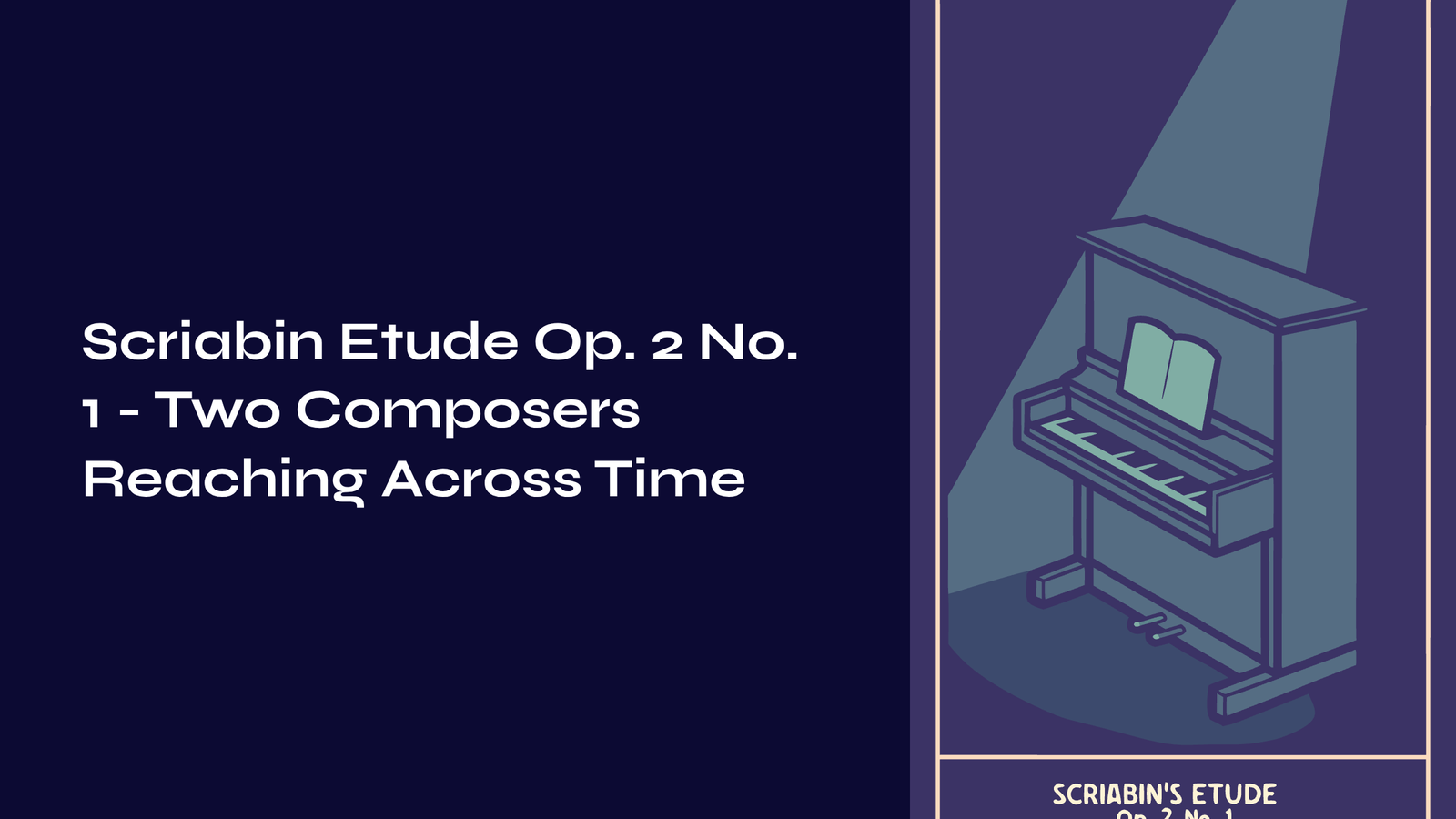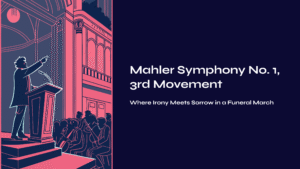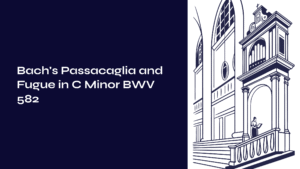Table of Contents
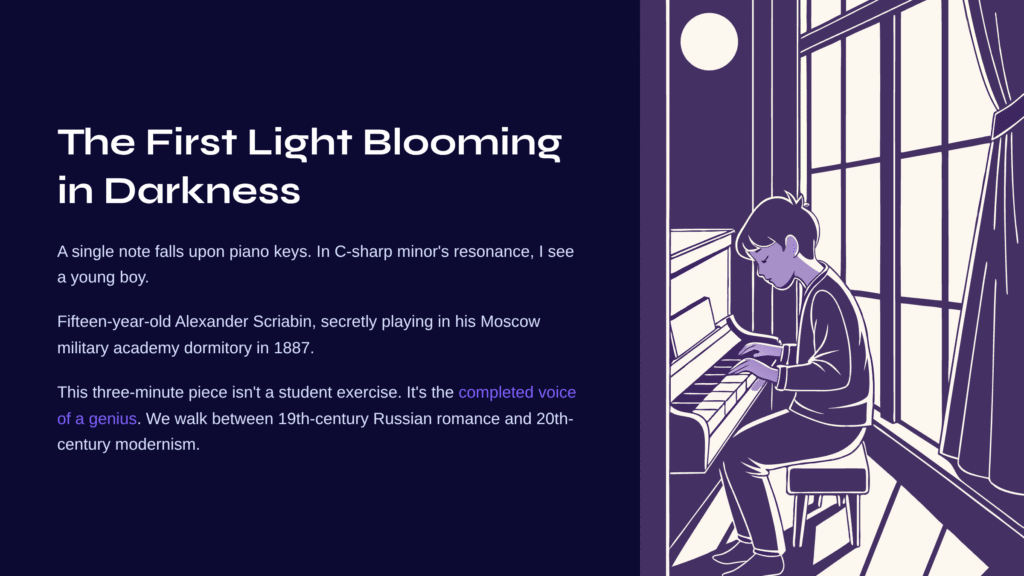
The First Light Blooming in Darkness
There is a first note that falls upon piano keys. In the deep, dark resonance of C-sharp minor, I always envision the figure of a young boy. That moment in 1887 when fifteen-year-old Alexander Scriabin secretly sat before a piano in his Moscow military academy dormitory.
Whenever I listen to Scriabin’s Etude Op. 2 No. 1, what strikes me is that this piece is far from a simple student exercise. Here already breathes the completed voice of a genius. In these brief three minutes, we walk between the final romance of 19th-century Russia and the prelude to 20th-century modernism.
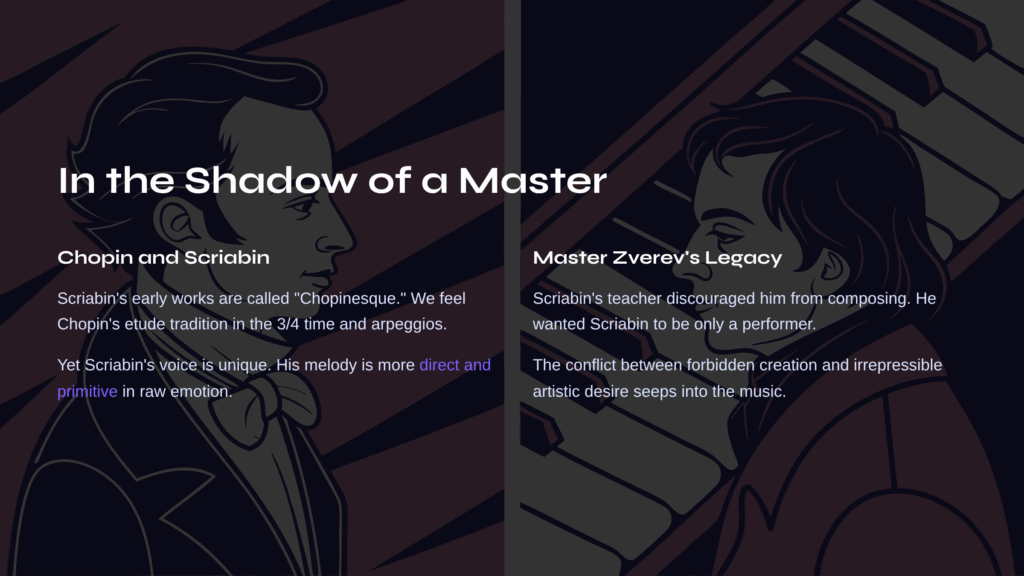
In the Shadow of a Master at Genius’s Starting Point
Chopin and Scriabin: A Handshake Across Centuries
Scriabin’s early works are often called “Chopinesque.” But I don’t think this description is entirely accurate. Certainly, we can feel the formal beauty of Chopin’s etude tradition in Op. 2 No. 1. The lyrical flow of 3/4 time, the wide arpeggios in the left hand, the plaintive melody in the right – all these elements evoke Chopin.
Yet listening closely, we already hear Scriabin’s unique voice. Rather than Chopin’s elegance, there’s something more direct and primitive in the raw emotion. Like a Russian Gypsy pouring out tears through violin, Scriabin’s melody is more savage, more heartbreaking.
The Complex Legacy of Master Zverev
What’s fascinating is the background of this piece’s creation. Scriabin’s piano teacher Zverev discouraged his student from composing, wanting him to grow only as a performer. But how could anyone stop the musical impulses bursting from a fifteen-year-old’s inner world? Scriabin initially intended to dedicate this piece to his teacher, but ultimately removed the dedication when published. What must his feelings have been? The conflict between guilt over forbidden creation and irrepressible artistic desire seeps directly into the music.
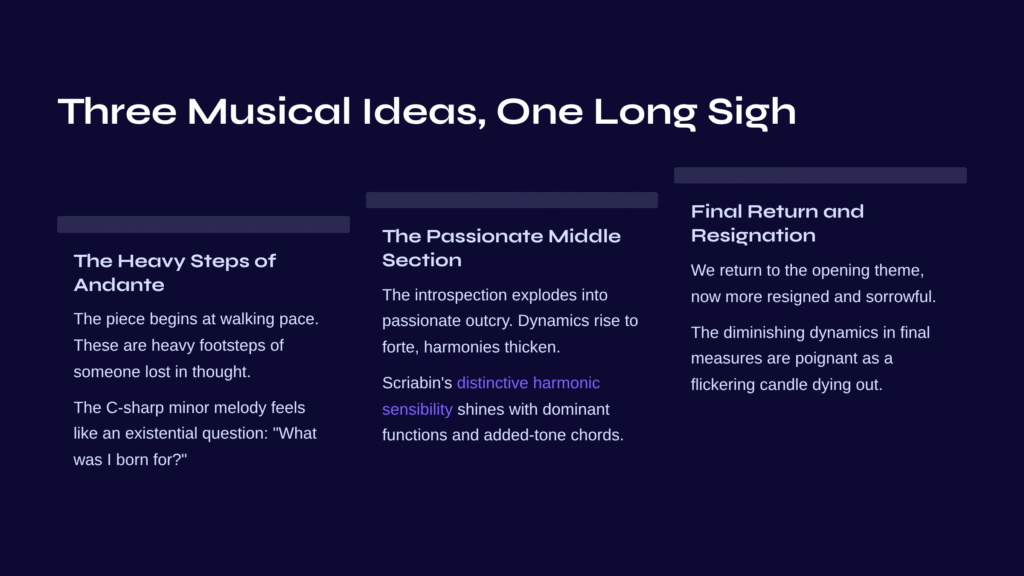
Three Musical Ideas, One Long Sigh
The Heavy Steps of Andante
The piece begins Andante – at walking pace. But this isn’t a stroll. These are the heavy footsteps of someone lost in deep thought, walking slowly. The main melody sung by the right hand in C-sharp minor’s darkness feels like a soliloquy. Like an existential question – “What was I born for?” – translated into musical notes.
The left hand accompaniment appears simple but is actually highly sophisticated. The harmonic colors continuously shift subtly while supporting the main melody. Like multiple shadows of slightly different hues overlapping to create one great shadow.
The Passionate Struggle of the Middle Section
In the middle section, the atmosphere suddenly changes. The introspective meditation explodes into passionate outcry. The dynamics rise to forte, the harmonies in both hands grow thicker. Listening to this passage, I always wonder: How could a fifteen-year-old express such a deep spectrum of emotion in music?
Here Scriabin’s distinctive harmonic sensibility shines. His love for dominant function, his preference for added-tone chords are already clearly evident. These characteristics would later become the seeds that developed into his mystic chord.
Final Return and the Beauty of Resignation
After the passion passes, we return to the opening theme. But this time it’s more resigned, more sorrowful. As if accepting, “Yes, this is ultimately my fate.” The gradually diminishing dynamics in the final measures are as poignant as a flickering candle dying out.
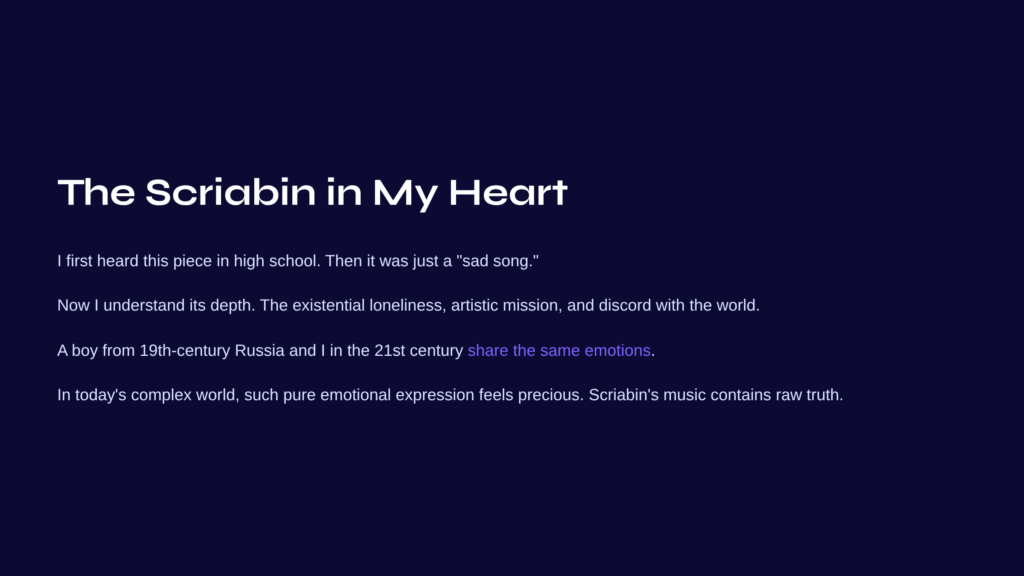
The Scriabin in My Heart
When I first heard this piece, I was in high school. Then I felt it only as a “sad song.” But as I’ve aged and listened repeatedly, I’ve gradually come to understand the depth this piece holds.
The solitude felt by fifteen-year-old Scriabin and what I feel now must be different. Yet the existential loneliness humans experience, the sense of artistic mission, the discord with the world – these things share common ground across time. Listening to this piece, I feel that a boy from 19th-century Russia and I in 21st-century share the same emotions.
Especially living in today’s complex, fast-paced world, sometimes such pure, direct emotional expression feels even more precious. Scriabin’s music contains unprocessed, raw truth. No vanity trying to show off technique, no calculation conscious of the audience. Just pure emotional outpouring from one human being’s inner world.
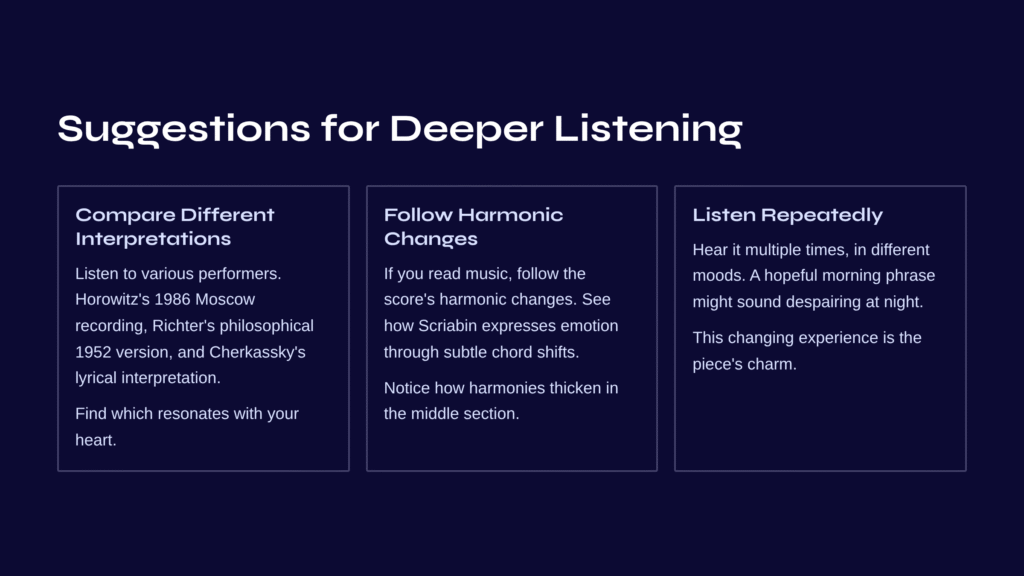
Several Suggestions for Deeper Listening
Comparing Different Performers’ Interpretations
To properly appreciate this piece, I recommend listening to various performers’ versions. Horowitz’s 1986 Moscow live recording holds historical significance – this version performed in Scriabin’s homeland carries special emotion. Richter’s 1952 recording is more philosophical and contemplative, while Cherkassky’s interpretation is more lyrical and gentle.
The emotional texture felt in each interpretation differs. Finding which version resonates more with your heart is one way to enjoy this piece.
Following Harmonic Changes with the Score
If you can read music, I recommend listening while following the harmonic changes. There’s real pleasure in seeing how Scriabin expresses emotional nuances through subtle chord changes. Particularly observe how the harmonies thicken and grow complex in the passionate middle section.
The Value of Repeated Listening
Such pieces aren’t understood in one hearing. They should be heard multiple times, at different times, in different moods. A phrase that sounds hopeful in the morning might sound despairing at night. This changing listening experience itself is the charm of this piece.
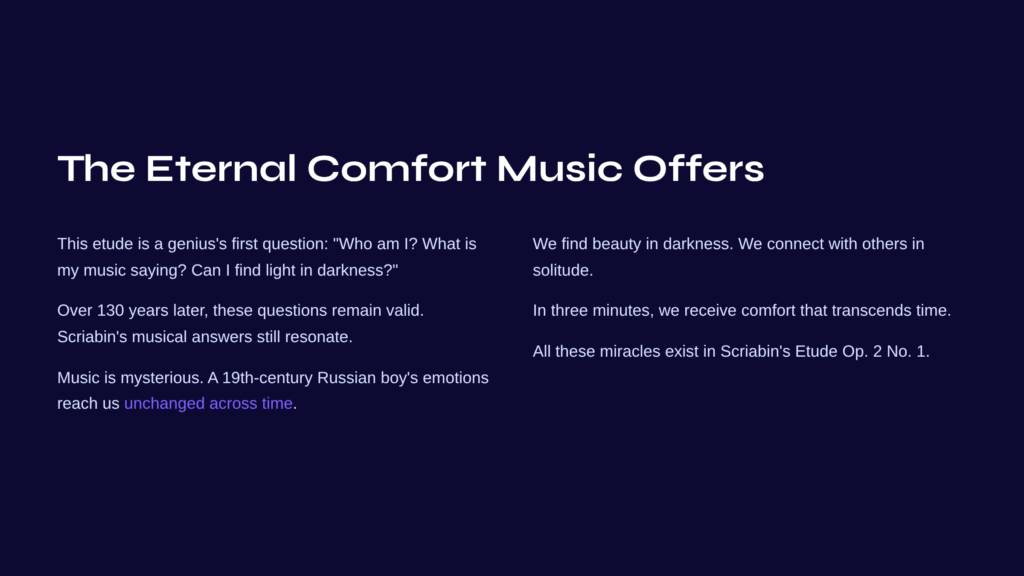
The Eternal Comfort Music Offers
Scriabin’s Etude Op. 2 No. 1 is not simply a piano miniature. This is the first real question a genius posed to the world at age fifteen: “Who am I? What is my music saying? Can I find light in this darkness?”
More than 130 years have passed, but these questions remain valid. And the answers Scriabin wrote in musical notes still resonate in our hearts today.
Music is truly mysterious. The emotions felt by a boy in 19th-century Russia reach us living in the 21st century unchanged. Transcending time, space, and language. Listening to Scriabin’s small etude, I think music’s greatest gift to humanity might be precisely this possibility of eternal communication.
That we can find beauty even in darkness, that we can connect with others even in solitude, that even in a brief three minutes we can receive comfort that transcends time. All these miracles are contained in Scriabin’s Etude Op. 2 No. 1.
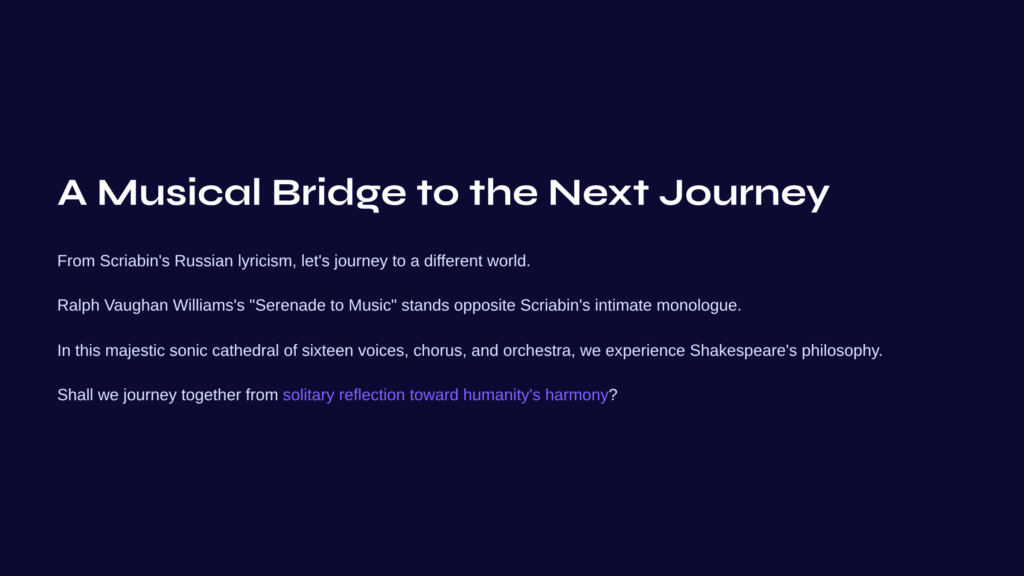
A Musical Bridge to the Next Journey
Having fully savored Scriabin’s poignant Russian lyricism, let me propose a journey to a completely different world. From a 19th-century Russian boy’s personal confession to the cosmic harmony that a 20th-century English composer painted through Shakespeare’s poetry.
Ralph Vaughan Williams’s “Serenade to Music” stands at the opposite pole from Scriabin’s intimate monologue. In the majestic sonic cathedral created by sixteen solo voices, chorus, and orchestra together, we experience firsthand Shakespeare’s philosophy that “music is the food of love.”
This musical journey from one composer’s solitary reflection toward the harmony of all humanity – shall we embark together?
